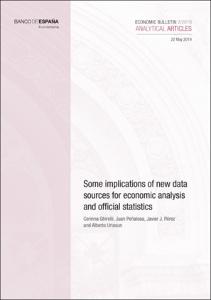Registro completo de metadatos
| Campo DC | Valor |
|---|---|
| dc.contributor.author | Ghirelli, Corinna |
| dc.contributor.author | Peñalosa, Juan |
| dc.contributor.author | Pérez, Javier J. |
| dc.contributor.author | Urtasun, Alberto |
| dc.date.accessioned | 2019-08-14T07:51:40Z |
| dc.date.available | 2019-08-14T07:51:40Z |
| dc.date.issued | 2019-05-22 |
| dc.identifier.uri | https://repositorio.bde.es/handle/123456789/9063 |
| dc.description | Artículo de revista |
| dc.description.abstract | On the backof new technologies, new data sources are emerging. These are of very high frequency, with greater granularity than traditional sources, and can be accessed across the board, in many cases, by the different economic agents. Such developments open up new avenues and new opportunities for official statistics and for economic analysis. From a central bank’s standpoint, the use and incorporation of these data into its traditional tasks poses significant challenges, arising from their management, storage, security and confidentiality. Further, there are problems with their statistical representativeness. Given that these data are available to many agents, and not exclusively to official statistics institutions, there is a risk that different measures of the same phenomenon may be generated, with heterogeneous quality standards, giving rise to confusion among the public. Some of these sources, which consist of unstructured data such as text, require new processing techniques so that they can be integrated into economic analysis in an appropriate format (quantitative). In addition, their use entails the incorporation of machine learning techniques, among others, into traditional analysis methodologies. This article reviews, from a central bank’s standpoint, some of the possibilities and implications of this new phenomenon for economic analysis and official statistics, with examples of recent studies |
| dc.format.extent | 12 p. |
| dc.language.iso | en |
| dc.relation.ispartof | Economic Bulletin / Banco de España, 2/2019 |
| dc.relation.hasversion | Versión en español 123456789/8457 |
| dc.rights | Reconocimiento-NoComercial-CompartirIgual 4.0 Internacional (CC BY-NC-SA 4.0) |
| dc.rights | In Copyright - Non Commercial Use Permitted |
| dc.rights.uri | https://creativecommons.org/licenses/by-nc-sa/4.0/deed.es_ES |
| dc.rights.uri | http://rightsstatements.org/vocab/InC-NC/1.0/ |
| dc.subject | New sources of economic information |
| dc.subject | Big data |
| dc.subject | Data science |
| dc.subject | Machine learning |
| dc.subject | Text analysis |
| dc.title | Some implications of new data sources for economic analysis and official statistics |
| dc.type | Artículo |
| dc.identifier.bdebib | 000466910 |
| dc.identifier.bdepub | ECBU-2019-2B-art15 |
| dc.subject.bde | Datos macroeconómicos generales |
| dc.subject.bde | Modelización econométrica |
| dc.subject.bde | Información e incertidumbre |
| dc.subject.bde | Métodos Econométricos y Estadísticos |
| dc.subject.bde | Técnicas informáticas |
| dc.subject.jel | C10 |
| dc.subject.jel | C18 |
| dc.subject.jel | C50 |
| dc.subject.jel | C80 |
| dc.subject.jel | D80 |












